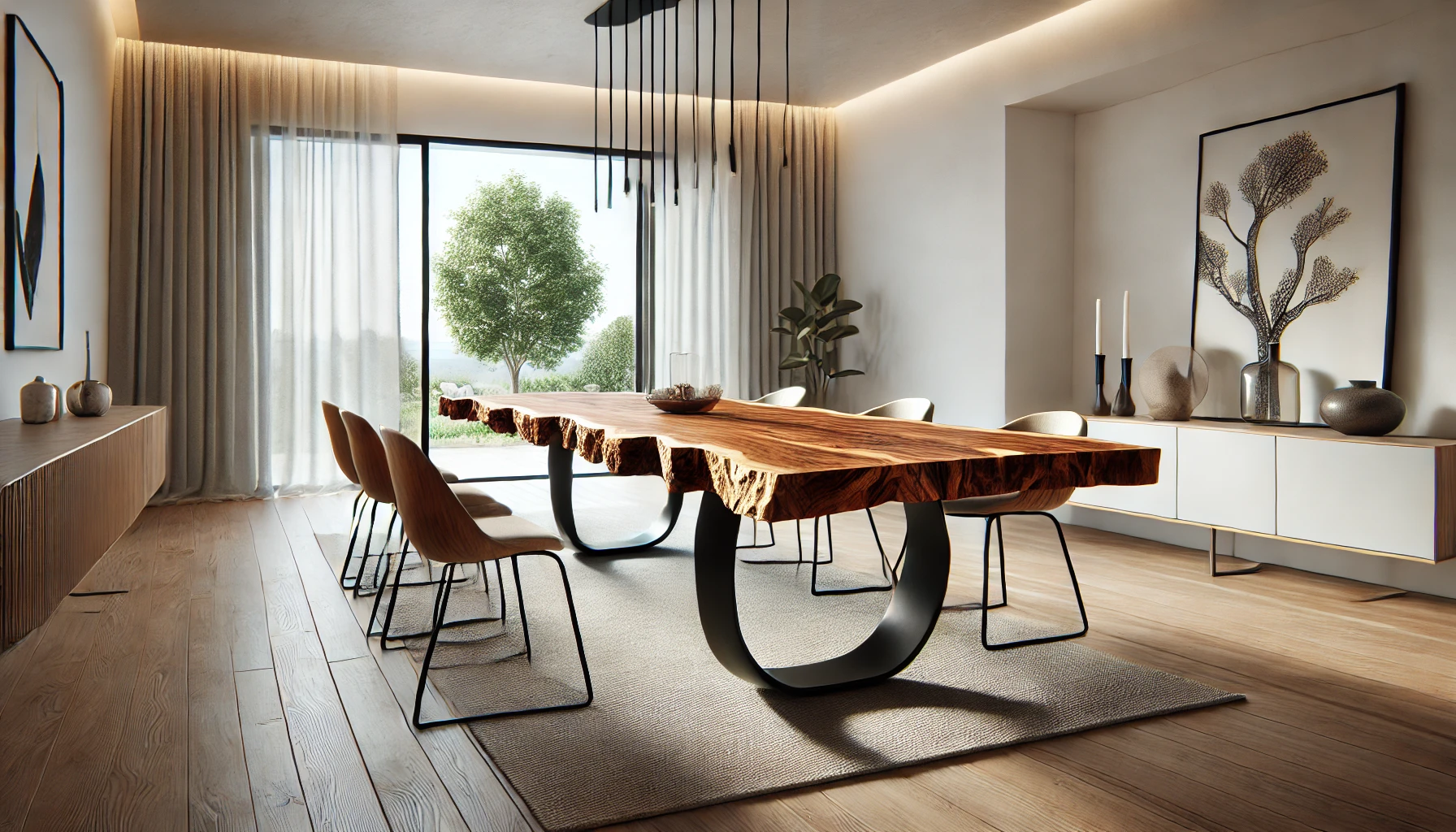What Is Live Edge Walnut? Understanding Its Elegance and Appeal
January 19, 2025 | Home Decor Trends | No Comments

What Is Live Edge Walnut?
Live edge walnut is a sought-after material in woodworking and furniture design, revered for its natural beauty and unparalleled character. Unlike traditional lumber, live edge walnut retains the tree’s natural contours and edges, giving each piece a unique, organic look that seamlessly blends rustic charm with modern elegance.
Whether you’re crafting a dining table, coffee table, or shelving unit, live edge walnut offers a timeless aesthetic that brings the outdoors inside. Let’s dive into what makes this material so special, how it’s cut, and the fascinating features you’ll find within it.
How Is Live Edge Walnut Cut?
The process of preparing live edge walnut begins with harvesting mature walnut trees. These trees, known for their dense, durable wood and rich colors, are carefully felled to preserve the integrity of the lumber. The cutting process focuses on maintaining the natural shape of the tree’s edges, which are often left intact rather than being squared off.
- Slab Cutting: Walnut logs are typically sawn into slabs using a bandsaw mill or chainsaw mill. Each slab is cut horizontally through the log to create wide, flat boards while keeping the natural edges intact.
- Drying: Once the slabs are cut, they are either air-dried, kiln-dried, or a combination of both. This step is crucial to reduce the wood’s moisture content and prevent warping or cracking during and after construction.
- Planing and Flattening: To create a usable surface, the slabs are planed and flattened. However, the live edge—the outer, irregular edge of the tree—is left untouched to retain its unique character.
Understanding the Sections of Walnut Lumber
A live edge walnut slab typically consists of three main sections:
- Heartwood:
- The heartwood is the innermost part of the tree and is known for its deep, rich brown tones with occasional hints of purple or reddish hues. It’s highly durable and resistant to decay, making it the most prized part of the walnut.
- Sapwood:
- Surrounding the heartwood is the sapwood, which is lighter in color, often creamy white or pale yellow. It adds a striking contrast to the darker heartwood and is sometimes left visible in furniture design.
- Live Edge:
- The live edge is the outermost part of the slab, showcasing the tree’s natural contours. It often includes the bark or the textured layer just beneath it, adding organic character to the piece.
Common Anomalies and Features in Live Edge Walnut
One of the reasons live edge walnut is so captivating is its natural imperfections, which tell the story of the tree’s life. Here are some common features you’ll encounter:
- Knots:
- Knots form where branches once grew. These dark, circular features add visual interest and can be a focal point in a finished piece.
- Grain Patterns:
- Walnut’s grain is typically straight but can also exhibit beautiful swirls and curls, especially around knots or imperfections.
- Burling:
- Burls are rounded growths on the tree caused by stress, injury, or infection. They create highly figured wood with intricate patterns, making them highly desirable for decorative purposes.
- Cracks and Checks:
- Natural cracks and splits can occur during the drying process or as the tree ages. These features are often stabilized with epoxy or butterfly joints to enhance both the aesthetics and structural integrity of the piece.
- Color Variation:
- Walnut exhibits a stunning range of colors, from the chocolatey tones of the heartwood to the creamy hues of the sapwood. The interplay of these shades creates a dynamic, eye-catching effect.
- Bug Holes:
- Evidence of past insect activity can sometimes be seen as small holes or tunnels. These add character and are often embraced in live edge designs.
Why Choose Live Edge Walnut for Your Project?
Live edge walnut isn’t just a material; it’s a statement. It brings:
- Timeless Beauty: The rich tones and unique grain patterns ensure that each piece is a one-of-a-kind masterpiece.
- Versatility: Whether your style is rustic, industrial, or contemporary, live edge walnut can complement any design aesthetic.
- Sustainability: Many suppliers prioritize sustainable harvesting practices, ensuring that walnut remains a renewable resource.
Caring for Your Live Edge Walnut Furniture
To keep your live edge walnut looking its best:
- Regular Cleaning: Use a soft, damp cloth to remove dust and debris.
- Avoid Harsh Chemicals: Stick to gentle cleaners to preserve the wood’s finish.
- Oil or Wax: Periodically apply oil or wax to maintain its luster and protect against drying.
Conclusion
Live edge walnut is more than just wood; it’s a celebration of nature’s artistry. Its rich hues, organic edges, and unique features make it a prized choice for furniture makers and design enthusiasts alike. Whether you’re a seasoned woodworker or a homeowner seeking a standout piece, live edge walnut offers unmatched beauty and character.
Looking to start your next project? Explore our selection of premium live edge walnut slabs and discover the perfect centerpiece for your home!
Contact Jenkins Artisan Woodshop now or visit us on our Facebook page to get started with your happiness!

